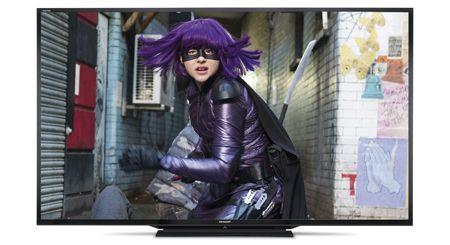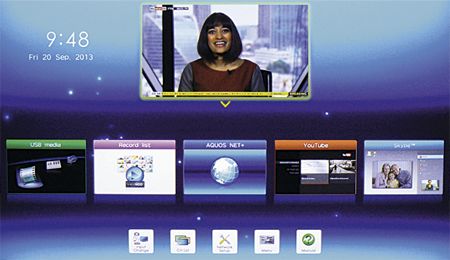Sharp LC-90LE757 review

It takes a lot to shock me these days, but the 90LE757 knocked me for the proverbial six in a number of ways. Firstly, it has Sharp’s name on it. This is somewhat startling, given that the brand’s TVs have been AWOL from my test bench for many months.
Secondly, the 90LE757’s 90in screen really is epic to behold, completely filling your field of view and turning any room into a bona fide cinema. I have, of course, seen a few 84/85in TVs recently, but it’s still surprising just how much extra impact five inches can have.
The final shock with the 90LE757 is its price. At £11,000 it isn’t nearly as expensive as I expected. Admittedly, Toshiba’s 84in 84L9363DB 4K TV sells for just £7,000, but adding incremental extra inches once you get up to the 90LE757’s size level is a costly business.
Despite my repeated mentions of 4K, I ought to stress that the 90LE757 is ‘only’ a Full HD set – until the recent CES show, Sharp didn't have a 4K consumer set on its books, and has been focusing on ultra-large TVs instead.
You may be wondering if a non-4K 90in TV really has a place any more. I’d argue it does on the grounds that a) a 90in 4K TV would cost more than £11,000, and b) 4K sources are still conspicuously absent.
Hard to missThe 90LE757 doesn’t wear its enormity particularly stylishly. Its frame is quite wide and the build quality seems average rather than outstanding. But you may be too busy staring at the vast screen to notice what’s around it.
Hiding on the set’s mighty rear are four HDMIs, an Ethernet port, and three USBs that support timeshifting as well as multimedia playback. The Sharp also supports Wi-Fi but only, surprisingly, via a supplied USB dongle. This sets alarm bells ringing as to how long ago the 90LE757 actually rolled off the Japanese firm's production line. At least the company has the decency to chuck the dongle in for free, something it hasn't seen fit to do with 3D glasses.
The 90LE757’s pictures are driven by a pseudo 200Hz system based on a 100Hz panel (at a time when many rivals sport 200Hz native panels and beefed-up rates of 1,000Hz and more), and you don’t get Sharp’s Quattron technology for adding a 4th yellow sub-pixel. More promising is that the X-GEN panel is lit by a direct LED system, where the lights are positioned behind the screen. This seems a better idea than a cheaper edge LED system, which would probably have struggled to work effectively with a 90in screen.
The 90LE757 provides a bountiful suite of image adjustments, including six-colour colour management, temperature and gamma tweaks, but it’s back into negative territory with its AQUOSNet+ Smart TV platform. This is painfully low on content, and the apps that are offered are generally of extremely limited interest. If you want a real 'net-connected experience, you're advised to partner this set with a dedicated media streamer.

Fortunately the 90LE757 hits its stride with its picture quality. Only minor calibration work was required to eke a very respectable colour performance out of Sharp’s monster. It handled the bold, almost cartoon-like palette of Pacific Rim and the much more muted palette and tricky skin tones of the final Harry Potter... film with equal aplomb. There’s plenty of punch to colours, too, even after I’d nudged down the screen’s brightness to get the best black levels.
This post-calibration black level response really is very good, as the direct LED system largely avoids any low-contrast greyness issues. There’s impressive light uniformity, too, with no major evidence of the haloing sometimes seen around bright objects on direct LED TVs.
Motion is handled well, without severe judder or blur even with the set’s motion processing turned off. And you should turn it off, for it tends to cause unwanted processing side effects when activated.
Despite the vast proportions of its pictures, noise with HD sources isn’t a major problem for the Sharp behemoth, provided you haven’t got either the contrast or sharpness settings raised too high. Yet there is a feeling that 90in is at the outer limit of what HD can comfortably expand to on a TV without crumbling, as the screen size is ruthless in its exposure of the slightest source imperfections. High-quality transfers, such as Pacific Rim on Blu-ray look little short of majestic, though.
Standard-definition material, not surprisingly, is a tougher watch, with the acreage of screen exposing clearly the digital compression noise so rife with SD broadcasts. And while the 90LE757’s upscaling system does make a decent fist of well-authored DVDs, buyers of this set should try to exist exclusively on an HD diet.
Snacking on active 3DGiven that 3D’s natural home is on huge screens I’d hoped the 90LE757 would eat Guillermo del Toro's sci-fi in 3D for breakfast, and donning Sharp’s active shutter 3D glasses really is a fun experience. The humongous panel provides the perfect forum for active 3D’s trick of revealing the Full HD resolution of 3D Blu-rays, and the screen’s brightness combats the dimming effect of the spex. The Sharp's strong contrast helps delineate a good sense of 3D space too, and motion is less juddery than expected.
There is a little crosstalk ghosting noise around distant objects, such as the lights of Pacific Rim’s shatterdome, but it’s not strong/common enough to be unbearable. The only really troubling 3D issue was a shadowy vertical bar down the picture. Sharp is adamant this is a flaw of our test sample rather than a normal phenomenon.
The 90LE757’s pictures clearly deserve a large-scale soundstage. Here, the Sharp does pretty well, using its huge chassis to house some quite potent speakers able to go fairly loud without becoming distorted or harsh. A little more treble clarity would have been appreciated, but this screen's sonics are well above the flat TV average.
Overall, despite feeling a bit dated, and even though you can get good projectors for much less money and Toshiba’s 84in 4K 84L9363DB for just £7000, the LC-90LE757 has still proved big enough and good enough to earn a place in my home cinema heart. Let’s hope Sharp uses it as a platform to build upon rather than disappearing off the radar again.
Specification
3D: Yes. Active
Ultra HD: No. 1,920 x 1,080
Tuner: Yes. Freeview HD
Connections: 4 x HDMI; RF input; headphone jack; D-Sub PC port; optical digital audio output; analogue audio output; component video input; composite video input; RGB Scart
Sound: 35W (10+10 with 15W subwoofer)
Brightness: 350cd/m2
Contrast ratio: N/A
Dimensions (off stand): 2,054(w) x 1,211(h) x 116(d)mm
Weight (off stand): 68kg
Features: Wi-Fi via USB dongle; Active Motion 200 processing system; multimedia playback from USB; timeshifting to USB; AQUOSNet+ Smart TV system; film dejudder; noise reduction; scanning backlight; Skype ready; DLNA support
 |
Home Cinema Choice #351 is on sale now, featuring: Samsung S95D flagship OLED TV; Ascendo loudspeakers; Pioneer VSA-LX805 AV receiver; UST projector roundup; 2024’s summer movies; Conan 4K; and more
|

















































